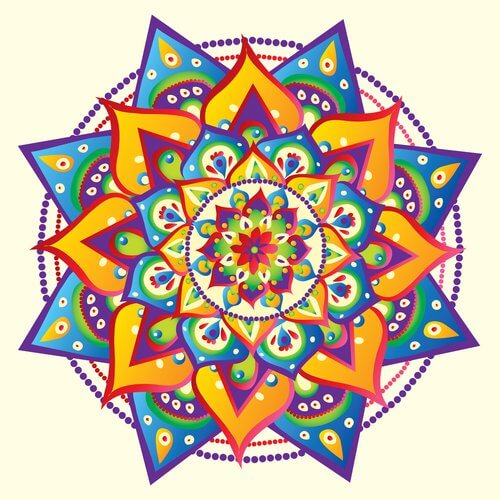Mandala is a Sanskrit term meaning “center, circle, magic ring. In the SAR (Royal Spanish Academy), it is defined as a complex design that is usually circular and represents the regulatory forces of the universe, serving as a means to meditation”. .
Generally, a mandala is a symbolic image based on geometric figures such as circle and square, which relate to the spiritual world.
- There is an infinite variety of mandalas.
- From simple figures to the most complex lotus or wheel shaped.
- That can be drawn on a sheet of paper.
- Painted or embroidered on fabric.
- Forming even the ground in some buildings.
They have been used since ancient times, having their origins in India, spread in Eastern culture and later, thanks to the Swiss psychiatrist Carl Gustav Jung, throughout the West, their importance is reflected in the wide dissemination between different cultures and religions.
Jung claimed that mandalas were the representation of the mind as a whole, from conscious to unconscious.
According to the spiritual vision, mandalas are like energy centers of balance and purification, which help us transform our vision of our environment and ourselves.
Anyone of any age can draw and paint a mandala, obtaining various benefits based on various research done, simply painting helps the person achieve a state of tranquility.
The shapes and colors used in mandalas express the thoughts, emotions and intuitions of the person who made them. The choice, they say, is not accidental. The same color, depending on the person’s mood, can have different meanings.
Mandalas usually represent the connection between the inner world and external reality. Designing and interpreting a mandala usually means coming into contact with one’s own intimacy. Each mandala has a meaning for the person who designs it.
Mandalas can be used in meditation or as a relaxation technique, the latter reinforcing the creative process of the person.
A 2005 study by Nancy A. Curry and Tim Kaser found that making sand mandalas was effective in reducing anxiety and stress levels.
Mandalas are like a form of meditation in action, as the person creates or observes the mandala, frees himself from his thoughts and clarifies his mind, help concentration and attention, as well as achieve mental stability and spiritual balance, deepening in himself. -knowledge.
Currently, mandala technique is used in education and rehabilitation
In the field of education, they are used as resources to improve children’s care and concentration, to develop specific motor skills, as well as media, expression and overcoming stressful emotional situations.
In some hospitals, mandalas are also offered to paint cancer patients as a means of relaxation and concentration.
We can work with mandalas in different ways
? Observing a mandala in a quiet place for three or five minutes, this practice is like a meditation exercise, using the mandala as a support, which will lead us to a state of relaxation and inner peace.
? Paint a mandala. To do this, we can search the internet or in a mandala book and choose the one that interests us most or that interests us, once selected, we can start painting it, paying attention to what we do.
? Create your own mandala. In this case, you must first draw the mandala and then paint it, this practice is the most recommended for personal work, once drawn and painted you will have to discover what it expresses through observation, even if you do not find meaning, the mandala unconsciously can have an effect on you.
Are you excited to discover the benefits of mandala?

